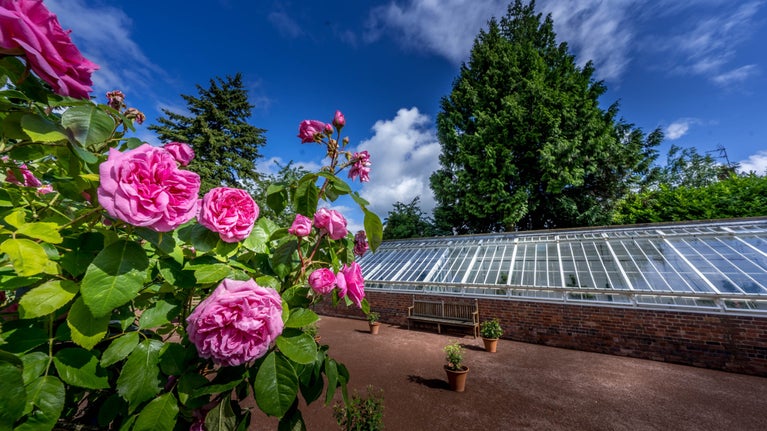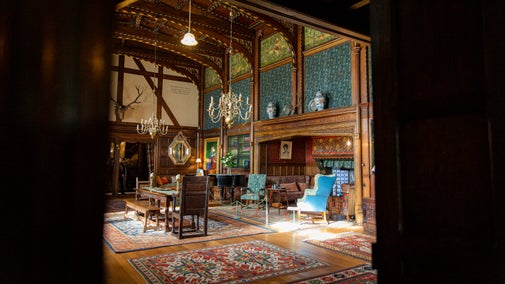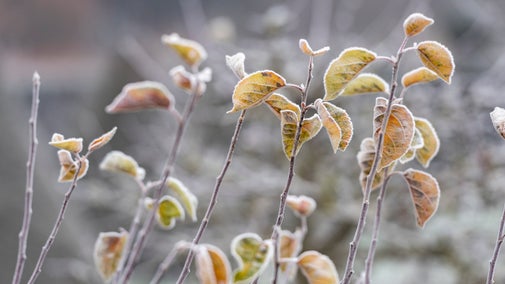
Discover more at Wightwick Manor and Gardens
Find out when Wightwick Manor and Gardens is open, how to get here, things to see and do and more.

The garden at Wightwick is the perfect place for a walk after enjoying the delights of the house. Originally designed by Thomas Mawson, today it has something to see, no matter what the season.
As autumn arrives, Wightwick’s gardens burst into a rich display of colour and seasonal activity. The air grows crisp, fruit ripens, seeds scatter, and birds flock to feast on berries, while the trees transform into a vibrant palette of reds, golds, oranges, and yellows. The sweeping views from the valley of the water garden up into the woodlands offer a fiery, jewel-like treescape, perfectly complementing the warm terracotta tones and intricate architecture of Wightwick’s historic walls and chimneys—recently restored as part of The Big MEND project. Visitors may even catch the sweet scent of the “candyfloss” tree and admire its striking colours reflected in the still water.
For the garden team, autumn brings busy but essential work.
The iconic yew hedges, central to Thomas Mawson’s original garden design, receive their annual trim, carefully shaped with string and spirit levels to achieve razor-sharp lines. Meanwhile, in the orchards, apples are harvested for sale, while ornamental fruits from hawthorns, mountain ashes, and wild roses provide vital food for birds and other wildlife.
November is dominated by leaf raking, not just to keep the grounds tidy but to recycle leaves into compost mulch, protect tree roots, and enrich the soil. Hedge cutting also takes place after the nesting season, while the herbaceous borders are left in “architectural decay,” with seedheads and stems standing tall to shelter wildlife and provide striking silhouettes after the first frosts.
Innovation also plays a role in the season. Head Gardener James has introduced “Dedging,” the creation of dead hedges from pruned branches and debris. These natural barriers recycle garden waste while enhancing wildlife habitats and adding structure to quieter corners of the grounds.
In 1904, the Manders employed the foremost Arts and Crafts garden designer, Thomas Mawson, to lay out their garden. Mawson was a renowned designer from Windermere and had designed many gardens.
The death of Flora Mander in 1905 meant his designs weren't fully implemented, but he returned in 1910 and added the South Terrace. The design and principles of what he wanted are still clear today.
The dominant design feature of the garden is its 'rooms' – areas of the garden marked by clipped yew hedges or terraces giving the garden a wide variety of different feelings.
Mawson designed these so that close to the house they are more formal, and then get more natural as you walk further into the garden
The Arts and Crafts movement in gardening renewed the love of classic English plants such as the rose. The garden boasts several varieties bordering the paths, lawns and in the formal rose garden. One of the most stunning is the pink and fragrant 'Gertrude Jekyll' in the Kitchen Garden.

Beyond the hedges and flower beds are the informal gardens. With two pools as central features they provide year-round interest with spring flowers, summer rhododendrons and autumn colour.

Just beyond the formal lawns and gardens are the two orchards which over recent years have been restocked with traditional varieties.
They’re a great place to sit under a tree with a picnic and relax. In the springtime, smell the honey-scented blossom, take shade under the branches in the summer and marvel at the array of colours in the autumn.
In the three orchards there's a wide range of fruiting trees including pear, quince, plum, damson, cherry and mulberry in the Kitchen Garden. Pear, plum, crab apple, medlar and apples grow in the Small Orchard. Eating, cooking and cider apples can be found in the Large Orchard.


Find out when Wightwick Manor and Gardens is open, how to get here, things to see and do and more.
Explore a home full of Pre-Raphaelite art and William Morris interiors, lovingly collected by Sir Geoffrey and Rosalie, Lady Mander.

Visit the De Morgan Gallery, a partnership with the De Morgan Foundation. ‘Look Beneath the Lustre’ looks at how Evelyn and William De Morgan were inspired to create art.

Find out more about volunteering at Wightwick Manor and how you can join the team that has been making Wightwick tick for over 60 years.

Discover the historic buildings at Wightwick and grab a bite to eat in the tea-room or stop by the shop or second-hand bookshop for the perfect souvenir of your visit.

Wightwick Manor and Gardens is a one pawprint rated place. Find out all you need to know to make the most of your visit with your four-legged friend.

From 18th-century water gardens and Arts and Crafts landscapes to intimate woodland gardens, there are so many places to discover.

Discover our gardeners’ top tips so you can make the most of your garden, plot or window box.

From masterpieces of Victorian garden design to open parklands, there are plenty of beautiful leafy places to explore in Shropshire and Staffordshire.
